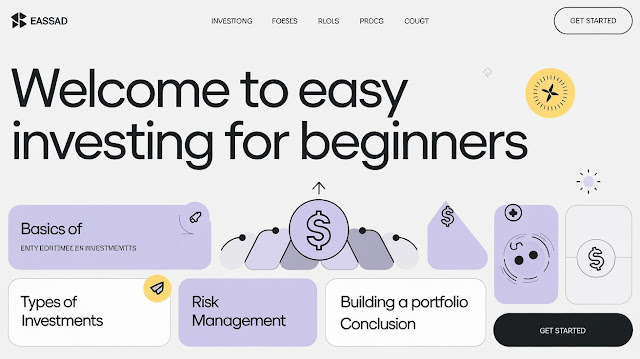How to Recover After a Bad Investment Decision for Beginners in 2025
Investing can be an excellent way to grow your wealth, but sometimes things don’t go as planned. If you’ve made a bad investment decision as a beginner, don’t panic. Recovering from a mistake is possible, and it can even provide valuable lessons for the future. Here's a step-by-step guide on how to get back on track after a bad investment.
1. Acknowledge the Mistake
The first step in recovering is to recognize what went wrong. Many beginners hesitate to face the issue, hoping it will resolve itself. Ignoring the problem will only make it worse. Review your decisions and try to pinpoint the cause of the loss. Was it a lack of research, emotional trading, or poor advice?
Key takeaway: Learn to view the mistake as part of your investment education, not as a failure.
Related Post: Top 10 Mistakes Beginners Make When Investing
2. Evaluate Your Financial Position
Assess how much the bad investment has impacted your overall finances. Ask yourself:
How much money did I lose?
Is this loss manageable, or does it create a significant financial strain?
Do I still have enough funds for other priorities like emergency savings?
Knowing the exact impact will help you create a recovery plan without unnecessary stress.
Important Tip: Create a spreadsheet to track the impact of losses and adjust your future budget allocations to stabilize your finances gradually. This practical approach minimizes panic and keeps you focused.
Further Reading: How to Build a Solid Budget Before Investing
3. Research and Understand What Went Wrong
Analyze the investment to identify the mistakes made. Some common reasons for bad investments include:
Lack of proper research: Investing based on trends rather than facts.
Emotional decisions: Letting fear or greed influence your actions.
Ignoring risk management: Not diversifying or overinvesting in one asset.
Important Tip: Consider seeking unbiased feedback from a knowledgeable community, such as online investment forums or local investing groups. Getting perspectives from others may help uncover blind spots you didn’t notice.
Tip: Keep a record of your mistakes so you can avoid repeating them.
Recommended Resource: Beginner's Guide to Investment Research
4. Adjust Your Investment Strategy
Rebuilding requires a better strategy moving forward. Here are some ways to create a solid plan:
Diversify your portfolio: Avoid putting all your money into one investment.
Set clear goals: Know why you’re investing—whether it’s for retirement, education, or a big purchase.
Focus on low-risk options initially: Look into ETFs, index funds, or blue-chip stocks as safer choices.
Important Tip: Start using a simulator to practice before committing real money again. Many platforms offer virtual accounts where you can test strategies risk-free.
Don’t Miss: What Are ETFs and Why Are They Great for Beginners?
5. Prioritize Risk Management
Good risk management can prevent future losses. Start implementing the following strategies:
Set stop-loss orders: This automatically sells an investment when it reaches a certain loss level.
Invest only what you can afford to lose: Avoid using borrowed money or funds meant for essential expenses.
Rebalance regularly: Keep your portfolio aligned with your financial goals and risk tolerance.
Important Tip: Try implementing the “5% rule.” Never allocate more than 5% of your portfolio to a single high-risk asset. This method caps potential losses while still allowing for some risk exposure.
Explore: How to Create a Balanced Portfolio
6. Consider Professional Advice
If you’re unsure how to proceed, consult with a financial advisor. A professional can:
Assess your financial situation.
Provide personalized advice on rebuilding your portfolio.
Help create a long-term investment strategy.
While there may be a cost involved, the guidance can save you from costly mistakes.
Important Tip: Research robo-advisors as a budget-friendly alternative. These platforms use algorithms to build and manage portfolios based on your risk tolerance and goals.
Check Out: What Are Robo-Advisors and How Do They Work?
7. Educate Yourself About Investing
The more you understand the basics of investing, the better equipped you’ll be to make informed decisions. Focus on learning:
How to read financial statements.
The importance of market trends and economic factors.
The difference between high-risk and low-risk investments.
Important Tip: Enroll in a free financial literacy program offered by libraries, nonprofits, or government organizations. These often provide tools and resources tailored for beginners.
Suggested Post: Top Free Resources to Learn About Investing
8. Start Small and Rebuild Confidence
Reinvesting after a loss can be intimidating. Ease back into the market with smaller investments. This approach will:
Help you test new strategies.
Allow you to learn without risking too much.
Rebuild your confidence over time.
Important Tip: Automate your investments using dollar-cost averaging. This strategy helps reduce the impact of market volatility and eliminates the need for precise market timing.
Learn More: Understanding Dollar-Cost Averaging
9. Focus on Long-Term Goals
One bad investment decision doesn’t define your entire journey. Remember, investing is a marathon, not a sprint. Keep your eyes on long-term wealth-building and avoid chasing quick wins.
Important Tip: Visualize your financial journey by creating a "future map" that outlines the milestones you aim to achieve. Seeing the bigger picture can help you stay focused despite short-term setbacks.
Patience and discipline are key to successful investing.
Further Guidance: How to Set Realistic Investment Goals
10. Build an Emergency Fund
Having a financial cushion can give you peace of mind. Before making new investments, ensure you have an emergency fund with at least 3-6 months of living expenses. This will help you stay financially stable in case of unexpected losses.
Important Tip: Keep your emergency fund in a high-yield savings account or money market account to ensure it grows while remaining accessible.
Read Next: Best Places to Park Your Emergency Fund
Conclusion
Recovering from a bad investment decision as a beginner may feel overwhelming, but it’s not the end of your financial journey. Acknowledge the mistake, learn from it, and focus on rebuilding with smarter strategies. By staying disciplined and continuously improving your knowledge, you can turn the setback into an opportunity for long-term financial growth.
Unique insight: Turn every mistake into a “teaching tool.” Reflect periodically on past errors, noting how each has shaped your current approach. Building resilience and adaptability is just as important as building wealth.
Remember: Every successful investor has faced losses at some point. What sets them apart is their ability to adapt and move forward.
Start Your Journey Today: Easy Investing for Beginners




.jpeg)

.jpg)




0 Comments